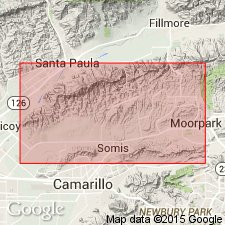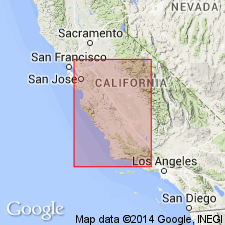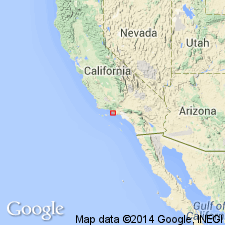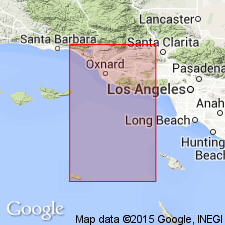
- Usage in publication:
-
- Las Posas formation
- Modifications:
-
- Original reference
- Dominant lithology:
-
- Sand
- Conglomerate
- AAPG geologic province:
-
- Los Angeles basin
- Ventura basin
Summary:
Pg. 325-345. Las Posas formation. In South Mountain area consists of 1,500+/- feet of loose sands and conglomerate alternating with beds of silty sand and gravel. In Las Posas Hills it consists of 75 feet of light-colored conglomerates and yellow to tan fine- to medium-grained sands. Overlaps Pico in some places and in other places appears to rest conformably on Santa Barbara beds (Upper Pico, Pliocene). Divided into Long Canyon member (above) and Katorama member (below). Is marine Pleistocene; equivalent to Upper San Pedro, Lower San Pedro, and "San Pedro Pliocene" of Deadman Island. Is = Saugus, which typically is terrestrial. It seems very unsatisfactory to use same name for both marine and terrestrial strata, which are so situated that their intertonguing phases cannot be traced, and for this reason the term Las Posas formation has been applied to the beds containing the Kalorama and Long Canyon faunas that come above the coolwater Santa Barbara in western part of the basin.
Source: US geologic names lexicon (USGS Bull. 896, p. 1153-1154).

- Usage in publication:
-
- Las Posas formation
- Modifications:
-
- Areal extent
- AAPG geologic province:
-
- Los Angeles basin
- Ventura basin
Summary:
Pg. 766. Las Posas formation is marine Saugus of Kew.
Source: US geologic names lexicon (USGS Bull. 896, p. 1153-1154).

- Usage in publication:
-
- Las Posas zone
- Modifications:
-
- Revised
- AAPG geologic province:
-
- Los Angeles basin
Summary:
Pg. 42-43, 61. Las Posas zone in Los Angeles basin is most characteristically exposed at Lomitas quarry and in Hilltop quarry, [San Pedro Hills, southern California]. It unconformably underlies Timms Point zone (=Deadman Island "Pliocene" of reports) and overlies Santa Barbara zone. Correlation with Las Posas of Ventura basin practically certain. Age is Pleistocene. [See Lomita formation.]
Source: US geologic names lexicon (USGS Bull. 896, p. 1153-1154).

- Usage in publication:
-
- Las Posas formation
- Modifications:
-
- Revised
- AAPG geologic province:
-
- Los Angeles basin
- Ventura basin
Summary:
Pg. 376. Stated Las Posas formation overlies Timms Point. (See under Timms Point formation.)
Source: US geologic names lexicon (USGS Bull. 896, p. 1153-1154).

- Usage in publication:
-
- Las Posas formation
- Modifications:
-
- Revised
- AAPG geologic province:
-
- Ventura basin
Summary:
Pg. 492-494. Kalorama member of Las Posas formation contains a typical Santa Barbara fauna and is here included in Santa Barbara formation. The upper half of the Santa Barbara is here tentatively placed in lower Pleistocene, instead of upper Pliocene.
Source: US geologic names lexicon (USGS Bull. 896, p. 1153-1154).

- Usage in publication:
-
- Las Posas formation†
- Modifications:
-
- Abandoned
- AAPG geologic province:
-
- Los Angeles basin
- Ventura basin
Summary:
Pg. 1557. †Las Posas formation. Name abandoned. San Pedro as defined in this paper synonymous with Pressler's (1929) Las Posas except that his so-called Kalorama member is retained in Santa Barbara formation.
Source: US geologic names lexicon (USGS Bull. 1200, p. 2113).

- Usage in publication:
-
- Las Posas formation
- Modifications:
-
- Age modified
- AAPG geologic province:
-
- Ventura basin
Summary:
Las Posas formation. Included in upper part of newly defined Hallian stage in Ventura basin.
Source: US geologic names lexicon (USGS Bull. 1200, p. 2113).
For more information, please contact Nancy Stamm, Geologic Names Committee Secretary.
Asterisk (*) indicates published by U.S. Geological Survey authors.
"No current usage" (†) implies that a name has been abandoned or has fallen into disuse. Former usage and, if known, replacement name given in parentheses ( ).
Slash (/) indicates name conflicts with nomenclatural guidelines (CSN, 1933; ACSN, 1961, 1970; NACSN, 1983, 2005, 2021). May be explained within brackets ([ ]).

